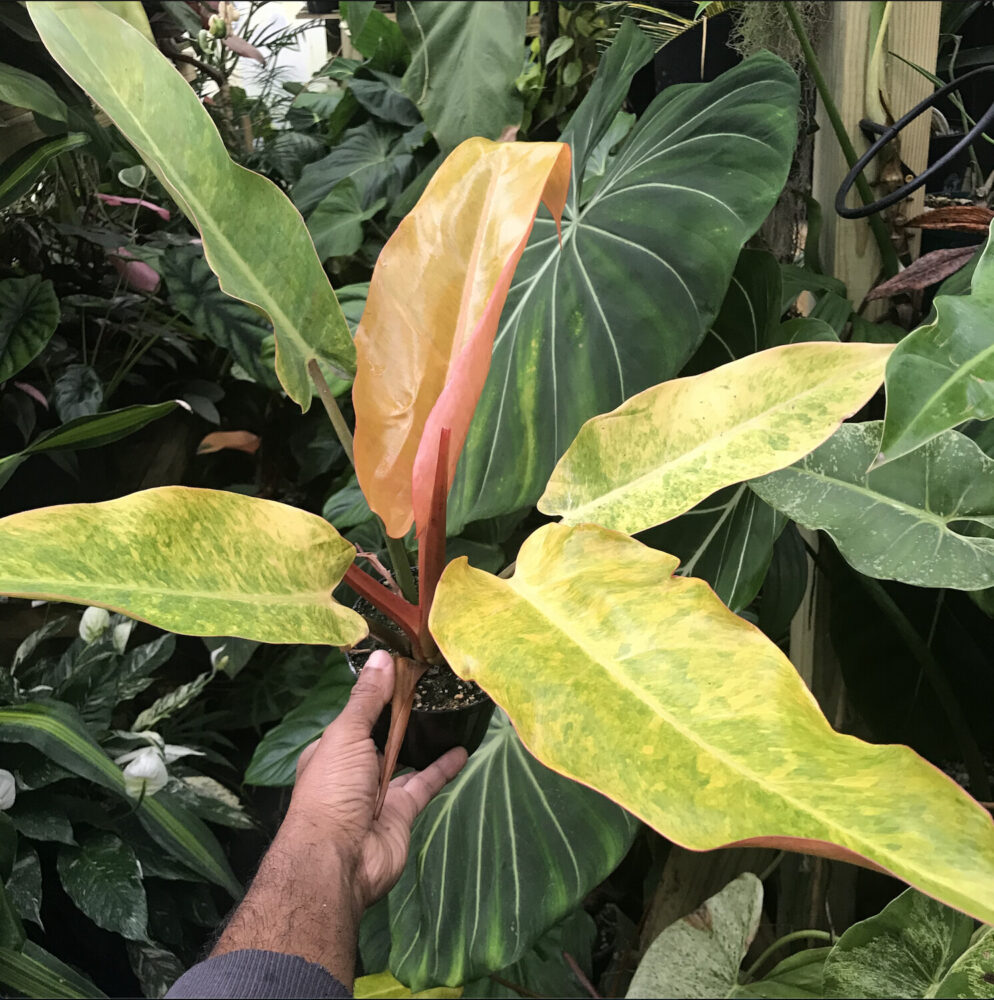Table of Contents
1. Introduction
The Philodendron Orange Marmalade is a tropical foliage native to the rainforests of South America. As a member of the Araceae family, it is cherished for its vibrant orange and green foliage. This flora is capable of infusing any indoor area with a vivid splash of color and vitality, making it a favored choice among plant lovers.



2. Appearance and Noteworthy Features
Distinguished by its ample, heart-shaped leaves flaunting mesmerizing shades of orange, green, and yellow, this plant is a sight to behold. The nascent leaves emerge resplendent in bright orange hues and progressively transition into deep green tones as they mature. The variegated patterns adorning the foliage make this plant an authentic visual enchantment.

3. Light and Temperature Prerequisites
To thrive and exhibit its vivacious hues, the Philodendron Orange Marmalade mandates bright, indirect illumination. Ideally positioned near a north or east-facing window, it basks in the gentle sun rays without being subjected to the glare of direct sunlight. This plant flourishes in a warm and humid ambiance, favoring temperatures within the range of 65-85°F (18-29°C).
4. Watering and Humidity Requisites
Achieving a delicate balance in watering proves pivotal for the well-being of this plant. Overwatering precipitates root rot, whereas underwatering causes wilting of the leaves. Maintaining the soil consistently moist, yet not waterlogged, is essential. Watering when the top inch of the soil appears slightly arid is advisable.
Sustaining an adequate humidity level is indispensable for this tropical beauty. Augment humidity by placing the plant atop a tray filled with water and pebbles or utilizing a humidifier. Regularly misting the leaves aids in providing the necessary moisture.
5. Soil Composition and Fertilization
Thriving in well-draining soil that retains moisture while facilitating proper drainage, this plant revels in a blend of peat moss, perlite, and conventional potting soil. Moreover, periodic application of balanced liquid fertilizer during the growing season fosters robust growth and resplendent foliage.
6. Methods of Propagation
Propagating the Philodendron Orange Marmalade through stem cuttings is a straightforward process. Select a healthy stem with at least two nodes and remove the lower leaves. Submerge or bury at least one node of the cutting in water or a well-draining potting mix. Provide the cutting with a warm and humid milieu, and within a few weeks, roots will begin to develop. Once the roots have established themselves, the cutting can be transferred to a pot.
7. Pruning Techniques and Maintenance
Routine pruning is highly advantageous for preserving the shape of this plant and encouraging new growth. Remove any yellow or damaged leaves, as well as any excessively elongated or overgrown stems. Pruning also enables size control, rendering it suitable for indoor spaces.
8. Common Pests and Diseases
While the plant exhibits relative resilience to pests, it may occasionally fall victim to mealybugs or spider mites. Vigilantly monitor the plant, regularly examining the leaves for signs of infestation. Early detection allows for easy management using organic insecticidal soap or neem oil.
9. Advantages of Cultivating Philodendron Orange Marmalade
Beyond its striking visual allure, the plant imparts several benefits to your indoor oasis. It purifies the air by eliminating harmful toxins, thus enhancing overall air quality. The presence of this vibrant plant cultivates a tranquil and soothing atmosphere, promoting well-being and alleviating stress.

10. Tips for Embellishing
The Philodendron Orange Marmalade can serve as an exceptional addition to your home decor. Here are a few tips to incorporate this plant into your interior design:
- Enhance its charm by placing it in an ornate pot or hanging basket, lending a vivid burst of color and verdure to your living space.
- Create a focal point by situating the plant near a blank wall or in an unoccupied corner.
- Combine it with other houseplants boasting contrasting foliage hues to fashion a visually captivating display.
11. Frequently Asked Questions
- Can the Philodendron Orange Marmalade be cultivated outdoors?
No, this plant thrives best in indoor environments, requiring warm and humid conditions.
- How frequently should I fertilize my Philodendron Orange Marmalade?
It is advisable to fertilize the plant once a month during the growing season.
- Is pruning necessary for the Philodendron Orange Marmalade?
Yes, regular pruning facilitates maintenance of the plant’s shape and encourages new growth.
- Can I propagate the Philodendron Orange Marmalade in water?
Absolutely, stem cuttings can be propagated in water or a well-draining potting mix.
- Is the Philodendron Orange Marmalade toxic to pets?
Yes, this plant poses a toxicity risk to cats and dogs if ingested. It is important to keep it out of the reach of curious pets.
12. Conclusion
The Philodendron Orange Marmalade stands as an enchanting plant that imbues any indoor oasis with vibrancy and beauty. With its resplendent orange and green foliage, low-maintenance requirements, and air-purifying abilities, it serves as an exemplary choice for both neophyte and seasoned horticulture enthusiasts. Embrace the allure of this tropical beauty and elevate the aesthetic appeal of your living space with the plant.
If you have any questions, you can contact us via:
- Instagram: Xanh Xanh Urban Forest
- Facebook: Xanh Xanh Urban Forest


Pingback: Philodendron Orange Marmalade: A Colorful Houseplant Choice